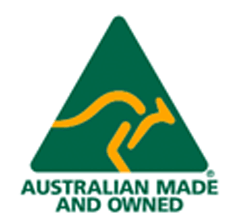Crumbles, Pellets, or Mash? Choosing the Right Feed Texture for Your Flock
Choosing the Right Feed Texture for Your Flock
A good diet is essential to productive, healthy laying hens. But did you know that the type of feed you choose makes a difference to nutrition? It's true - feed texture is important for healthy, happy hens.
Key Takeaways:
- Chickens can eat mash, crumbles, grain mix or pellets—each has pros and cons.
- Feed texture affects digestion, waste, nutrition, cost, and feeder compatibility.
- Pellets are the healthiest option for use with Dine-A-Chook Feeders, reducing mess, waste and mold risk.
- Chickens may need time to adjust when switching feed forms.
What Are the Different Types of Chicken Feed?
When choosing a feed for your backyard flock, it’s not just about the ingredients—it’s also about the form. The four most common types of commercial feed are:
- Mash – A fine, powdery feed
- Crumbles – Coarse bits about the size of cracked grain
- Grain mix - A mix of grain that is either whole or cracked
- Pellets – Cylindrical compacted feed, uniform in size
Depending on the type of feed, all of these forms of feed can contain identical nutrients. For example, a complete feed in any form will contain all of the protein, calcium, vitamins and other nutrients that hens need to thrive. But the form or texture of the feed will change how your chickens eat, affecting nutrition and how much feed ends up wasted on the ground.
Let's look at the pros and cons of different chicken feed types:
Mash: Fine and Flexible, but Often Messy
Mash is the most basic form of chicken feed. It’s often used for young chicks or mixed with water to form a wet "porridge."
Pros:
- Easy for chicks and pullets to eat
- Can be fermented for gut health
- Offers flexibility (dry or wet feeding)
Cons:
- Can be very dusty
- Vitamins and minerals can sink to the bottom of the mix, leading to malnutrition
- Prone to spilling and feed waste
- Not ideal for gravity feeders like Dine-A-Chook
- Tends to mold
Best for: Chick starters or keepers who want to ferment feed. Less suitable for busy backyard keepers who prefer tidy feeding.
Crumbles: A Middle Ground
Crumbles are basically mashed pellets—small, bite-sized fragments with a coarse texture. They’re a good choice if your birds don’t like pellets or need an easier feed to consume.
Pros:
- Easier to eat than pellets, especially for young hens
- Less dusty than mash
- Flows well in most feeders
Cons:
- Still more prone to spillage than pellets
- Can clog up some gravity feeders if it’s too fine or moist
Best for: Growers or adult hens that don’t take to pellets. A good balance between digestibility and tidiness.
Grain Mix: A No Go
Grain mix can come in a mash or crumble form. The difference is that, instead of a mash or crumble where the feed is uniform, in a grain mix chickens can easily see the different components. While grain mix looks appealing, like muesli, it is the worst feed type for chickens.
Pros:
- Use as a treat: a small amount of grain each day aids digestion
Cons:
- Encourages spilling as chickens seek out their favourite ingredients
- Less favoured ingredients, often including protein-rich pellets, are wasted
- Vitamins and minerals are usually added in powder form and sink to the bottom and are wasted
- Leads to malnutrition and obesity
Avoid.
Pellets: Cleaner Feeding, Less Waste
Pellets are the most popular choice for backyard chicken keepers who value efficiency and cleanliness. The uniform shape and size mean they’re easy to manage in automatic and gravity-fed systems.
Pros:
- Less feed waste—harder for chickens to flick or scratch out
- Flows smoothly in feeders like Dine-A-Chook
- Lower dust and mold risk
- Easy to store and measure
Cons:
- Chickens may take time to adjust if switching from mash or crumbles
- Some picky birds need encouragement at first
Best for: Adult hens and roosters. Ideal for use with Dine-A-Chook poultry feeders, which are designed to minimize mess and prevent moisture buildup when using pellets.
What Works Best With a Dine-A-Chook Feeder?
Dine-A-Chook feeders are optimized for pelleted feed. Their patented gravity-fed design, combined with a moisture-controlled feeding bay, allows pellets to flow smoothly without clumping, clogging, or spilling.
Can you use crumbles? Yes—but make sure the crumble texture isn’t too fine, or it may compact inside the feeder and reduce flow.
Mash is not recommended for Dine-A-Chook systems due to its powdery texture, which can clog the bay and increase mold risk.
Tips for Switching Feed Types
Changing feed form is usually simple, but chickens can be surprisingly picky. Here’s how to make the transition easier:
- Mix old and new feed gradually over 5–7 days.
- Limit other treats during the transition.
- Offer feed in small portions so it stays fresh.
- Ensure your feeder is clean and dry—especially when changing textures.
- If your chickens initially ignore pellets, be patient. Most flocks adjust quickly when they realize that’s what’s on the menu!
Final Thoughts
Whether you choose mash, crumbles, or pellets, the right feed texture depends on your flock’s age, behavior, and your feeder setup. For clean, low-waste feeding in a backyard environment, pellets remain the gold standard—especially when paired with a purpose-built feeder like Dine-A-Chook.
Feeding your flock well is one of the easiest ways to support their health, save money on wasted feed, and make daily care a little simpler.
Happy chicken keeping!
Rachael at Dine-A-Chook USA






